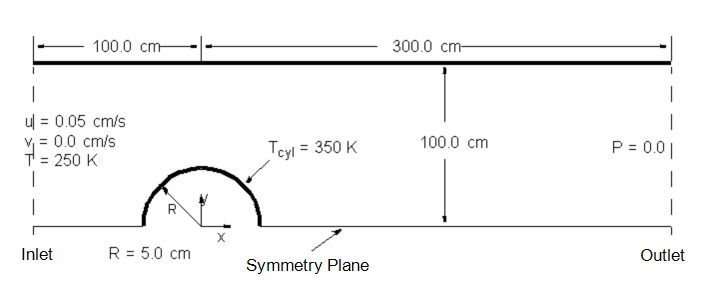Laminar Flow Over Heated Cylinder
Analysis Characteristics
- Steady-state
- 2D internal flow
- Laminar
- Incompressible
- Forced convection
Reference
Holman, J.P., Heat Transfer, 5th Edition, McGraw-Hill, 1981.
Problem Description
A circular cylinder with an infinitely long axis (thus approximated as 2D) is immersed in a laminar flow with a Reynolds number of 50 (based on the diameter of the cylinder). The cylinder wall has a fixed temperature 100 K higher than the fluid bulk temperature. This model is analyzed to verify the fluid flow and heat transfer modeling capabilities of Autodesk® CFD.
Accuracy is assessed by comparing two expressions for Nusselt number. One is an experimental correlation and the other is an analytical derivation. The experimental correlation is extracted from Holman (1981):

The subscript “e” indicates experimental. The analytical derivation is:

The subscript “a” indicates analytical.
- Q is the heat flux into the fluid (in watts)
- L and D are the length (unit length into the page) and diameter of the cylinder
- k is the conductivity of the fluid, h is the film coefficient
- Tcyl is the fixed temperature of the cylinder
- Tin is the bulk temperature of the incoming fluid.
Geometry and Boundary Conditions

Results
Using Re=50 (based on cylinder diameter), Q=17.08 watts, Pr=6.97, and the known geometry and boundary condition data, the following results are computed:
| Benchmark | 2018: Build 20170308 | % Error | 2019: Build 20180130 | % Error |
| Nue = 8.29 | Nua = 8.221 | 0.825 | Nua = 8.34 | 0.690 |
